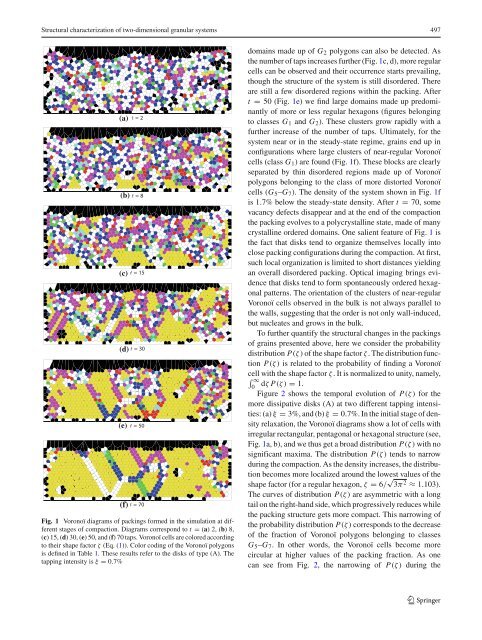Structural characterization of two-dimensional granular ... - Springer
Structural characterization of two-dimensional granular ... - Springer
Structural characterization of two-dimensional granular ... - Springer
You also want an ePaper? Increase the reach of your titles
YUMPU automatically turns print PDFs into web optimized ePapers that Google loves.
<strong>Structural</strong> <strong>characterization</strong> <strong>of</strong> <strong>two</strong>-<strong>dimensional</strong> <strong>granular</strong> systems 497(a)(b)(c)(d)(e)(f)Fig. 1 Voronoï diagrams <strong>of</strong> packings formed in the simulation at differentstages <strong>of</strong> compaction. Diagrams correspond to t = (a) 2,(b) 8,(c) 15, (d) 30, (e) 50, and (f) 70 taps. Voronoï cells are colored accordingto their shape factor ζ (Eq. (1)). Color coding <strong>of</strong> the Voronoï polygonsis defined in Table 1. These results refer to the disks <strong>of</strong> type (A). Thetapping intensity is ξ = 0.7%domains made up <strong>of</strong> G 2 polygons can also be detected. Asthe number <strong>of</strong> taps increases further (Fig. 1c, d), more regularcells can be observed and their occurrence starts prevailing,though the structure <strong>of</strong> the system is still disordered. Thereare still a few disordered regions within the packing. Aftert = 50 (Fig. 1e) we find large domains made up predominantly<strong>of</strong> more or less regular hexagons (figures belongingto classes G 1 and G 2 ). These clusters grow rapidly with afurther increase <strong>of</strong> the number <strong>of</strong> taps. Ultimately, for thesystem near or in the steady-state regime, grains end up inconfigurations where large clusters <strong>of</strong> near-regular Voronoïcells (class G 1 ) are found (Fig. 1f). These blocks are clearlyseparated by thin disordered regions made up <strong>of</strong> Voronoïpolygons belonging to the class <strong>of</strong> more distorted Voronoïcells (G 5 –G 7 ). The density <strong>of</strong> the system shown in Fig. 1fis 1.7% below the steady-state density. After t = 70, somevacancy defects disappear and at the end <strong>of</strong> the compactionthe packing evolves to a polycrystalline state, made <strong>of</strong> manycrystalline ordered domains. One salient feature <strong>of</strong> Fig. 1 isthe fact that disks tend to organize themselves locally intoclose packing configurations during the compaction. At first,such local organization is limited to short distances yieldingan overall disordered packing. Optical imaging brings evidencethat disks tend to form spontaneously ordered hexagonalpatterns. The orientation <strong>of</strong> the clusters <strong>of</strong> near-regularVoronoï cells observed in the bulk is not always parallel tothe walls, suggesting that the order is not only wall-induced,but nucleates and grows in the bulk.To further quantify the structural changes in the packings<strong>of</strong> grains presented above, here we consider the probabilitydistribution P(ζ ) <strong>of</strong> the shape factor ζ . The distribution functionP(ζ ) is related to the probability <strong>of</strong> finding a Voronoïcell with the shape factor ζ . It is normalized to unity, namely,∫ ∞0dζ P(ζ ) = 1.Figure 2 shows the temporal evolution <strong>of</strong> P(ζ ) for themore dissipative disks (A) at <strong>two</strong> different tapping intensities:(a) ξ = 3%, and (b) ξ = 0.7%. In the initial stage <strong>of</strong> densityrelaxation, the Voronoï diagrams show a lot <strong>of</strong> cells withirregular rectangular, pentagonal or hexagonal structure (see,Fig. 1a, b), and we thus get a broad distribution P(ζ ) with nosignificant maxima. The distribution P(ζ ) tends to narrowduring the compaction. As the density increases, the distributionbecomes more localized around the lowest values <strong>of</strong> theshape factor (for a regular hexagon, ζ = 6/ √ 3π 2 ≈ 1.103).The curves <strong>of</strong> distribution P(ζ ) are asymmetric with a longtail on the right-hand side, which progressively reduces whilethe packing structure gets more compact. This narrowing <strong>of</strong>the probability distribution P(ζ ) corresponds to the decrease<strong>of</strong> the fraction <strong>of</strong> Voronoï polygons belonging to classesG 5 –G 7 . In other words, the Voronoï cells become morecircular at higher values <strong>of</strong> the packing fraction. As onecan see from Fig. 2, the narrowing <strong>of</strong> P(ζ ) during the123
















